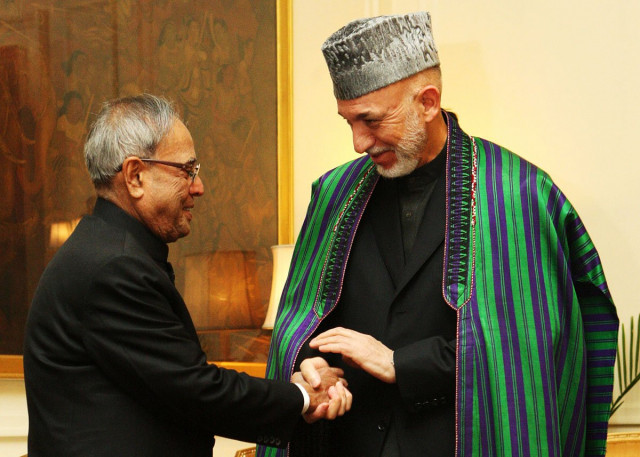Analysis: Pakistan’s Afghan Policy - need for simplification
It seems Karzai will seek to employ whatever leverage that they feel is available to ensure survival of their regime.

This handout photograph received from the Presidential Palace on May 21, 2013, India President, Pranab Mukherjee (L) shakes hands with Afghan President, Hamid Karzai during a meeting at the Presidential Palace in New Delhi. PHOTO: AFP/FILE
Hamid Karzai’s current visit to Delhi brings into sharp focus some of the underlying variables that will confront Pakistan as the drawdown of Nato forces begins in earnest. For the duration of this period almost every facet of the relationship between Islamabad, Washington and Kabul will be held hostage to the American need to exit Afghanistan while leaving some semblance of its strategic credibility intact.
It seems more than likely that Karzai will seek to employ whatever leverage that they feel is available to ensure the survival of their regime. Public posturing aside, Karzai will more likely than not seek to return to office once his term comes to an end with elections due in April next year.
His so-called strategic embrace of India is part of a somewhat desperate attempt to provide protection for his faltering regime once Washington exits. It is quite clear that Karzai has based his approach on a fundamentally flawed assumption; that by seeking Delhi’s protection Islamabad will be forced into a corner and will seek to attain his cooperation by curtailing Taliban activity thereby making it easier for his regime to survive the Post-Withdrawal environment. At the very least, a supposed Indian presence could be employed to keep Pakistan’s leverage over the emerging political architecture within Afghanistan in check. This fundamental miscalculation on his part, coupled with increasing American irritability with his behaviour, makes his long-term sustainability suspect. Islamabad would be foolish to take Karzai seriously in any way shape or form. There are other Pashtun alternatives to the Pashtun Karzai. He does, at best, have a limited shelf-life which will dissipate fairly quickly given the fraught nature of Afghan affairs.
The real conundrum for Islamabad begins once the bulk of Nato’s forces have vacated Afghanistan. It appears fairly certain that the withdrawal of American forces will only serve to leave behind an Afghanistan that is deeply fractured and perhaps unsustainable in its current form. At the very least, ethnic and tribal variables will continue to pull that country in so many opposed directions that any form of efficient governance will prove to be impossible to initiate or sustain.
Where does this leave Pakistan? Should Islamabad pursue a tactically aggressive but strategically futile foray into Afghanistan? Perhaps a more benign approach where Pakistan seeks to serve as an interlocutor between various Afghan factions? One fact is certain, pursuing a less active policy approach is not viable owing to the linkages that prevail between Pakistan’s northern areas and Pashtun dominated southern Afghanistan.
What then are Pakistan’s options if passivity and tactical aggressiveness are equally unviable? The answer lies in determining the kind of Afghanistan that is least damaging to Pakistan’s long-term interests. It appears that three possible scenarios could emerge. In scenario one, Nato forces withdraw with security related operations being handed over to the Afghan National Army, which then serves as guarantor of some semblance of internal stability with Karzai continuing in his current capacity. This scenario is unrealistic owing in large part to the inefficiencies of the Afghan National Army. In scenario two, Nato forces withdraw but leave behind a chaotic Afghan political dispensation in its wake which could then descend into internecine warfare. The emergence of this scenario is a distinct possibility with Pakistan’s tribal areas falling further into the abyss of instability. In scenario three, Nato forces withdraw leaving behind an unstable Afghan government with Karzai eventually being replaced by another Pashtun tribal leader whose writ would not extend much beyond Kabul. Ethnic and tribal tensions will characterise the Afghan state with internecine warfare being the norm rather than the exception. In other words, Afghanistan will return to a state where lawlessness and chaos reign supreme. This scenario is also a distinct possibility.
Regardless of which scenario comes into effect, a significant degree of chaos is bound to ensue within Afghanistan in the post-2014 period. Pakistan’s tribal areas will be indelibly affected by whatever scenario emerges owing to the amorphous nature of the Durand Line. Consequently, Pakistani policymakers would be well advised to simplify what they feel can be achieved in Afghanistan and should as such hastily abandon any grandiose geostrategic notions.
The author is a PhD in politics from Bristol University
Published in The Express Tribune, May 23rd, 2013.





1701351241-1/Afghan-refugees-(3)1701351241-1-208x130.webp)













COMMENTS
Comments are moderated and generally will be posted if they are on-topic and not abusive.
For more information, please see our Comments FAQ